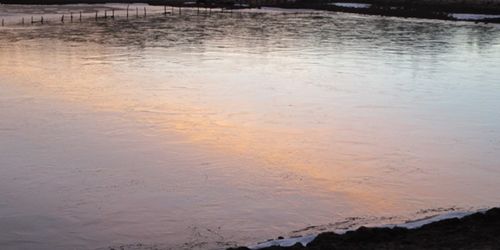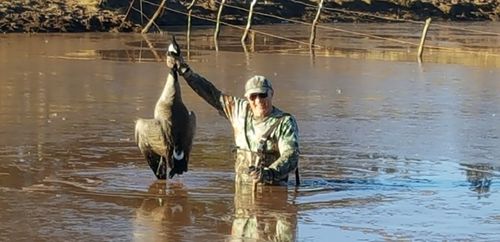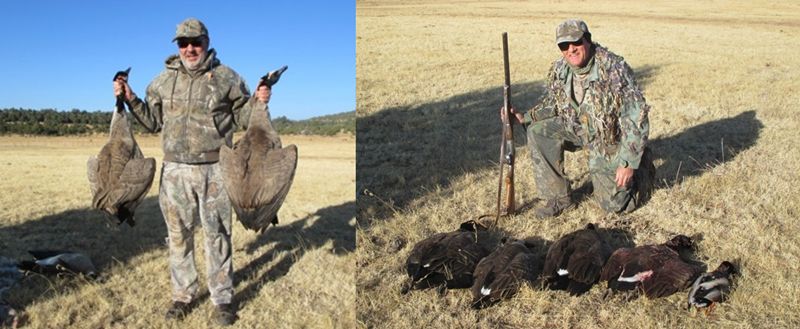
| Articles | Documents | Equipment | Events | Links | Membership | Miscellaneous | Scrapbook | Targets | What's New |
| Wild Goose Chase | March 2018 | ||
| Gerhard Schroeder
| |||
|
Getting up and going rather early, we arrived at first light at one of the
waterholes that almost always had ducks on it. Not that day, and it had
evaporated to the lowest level I’ve so far seen. Also, thin ice covered about
half of it.
Ditto with hole #2. Worse, #3 was almost completely iced up. That’s when Ron
mentioned that he’s smelling skunk.
That ‘smell’ intensified with every hole we visited. And some were even without
ice. Was it too early, meaning the birds hadn’t come here yet from places like
Montana, Idaho, Utah?
Hole #7 was also iced over completely. At #8 we had a late lunch. Thrill had
been at each of them: circle on down below the berm, insert ear plugs, take
safety off, and gently ‘charge’ up the last few feet of the bank to finally
view the water. Each time that’s all we saw. Water, or ice, and nothing on
it or departing from it. Or we could see part of the water’s surface from
further away, check it over with binoculars. Then inch forward until more water
was revealed, and work the binos again. And again, until all of the shore line
was visible, as ducks sometime sit along the bank. That day, each time – nothing.
Hunting is not about giving up. So we pressed on. When we had visited pond #10,
time had advanced past 2:30PM, and that day’s skunk stink was mighty. The next
hole again allowed an inspection by binocular. Finally, something was floating
on the water. Geese!
Neither of us smelled that skunk any longer. Of course we still needed to do our
part. So we parked the 4Runner where distance to the berm, without being seen by
the birds, was closest. Now steel BBs resided in our chambers. That berm could
not come soon enough.
When we topped it, a small war broke out. In sheer terror ducks and geese fled
with frantic wingbeats. One mallard drake, unfortunate enough to fly right along
a Canadian I had swung on, and four geese, did not make the departure.
The pellets ripped into the water all around it, but apparently none hit neck or
head. We waited too long, should have been running over there instead of blasting.
When that goose reached land and proceeded in infantry fashion, Ron gave chase.
Only to lose it in the trees. Meanwhile I hurried to the left, and managed to
finish off the last swimmer just before landfall. Then I joined Ron. But no luck,
that goose seemed to have gotten away.
So we returned to the pond and collected the birds which the wind by then had
carried to shore. One goose however, had dropped right into the remaining ice.
Time to do the retrieving.
Relax! No dropping of my britches this time. On a Black Friday I had purchased
waders for half price, now still in my Toyota. On my way there I purposely
zig-zagged through the trees. And bingo, about a quarter mile from the water,
the wounded goose flushed, with considerable speed. My first two shots did not
kill. But the big Canadian slowed. I calmly advanced. Then one more hail of
steel #4s collapsed the big bird, with wings flailing.
OK, one more goose to get. I fetched the waders and carefully played the retriever.
A walking stick of some sort seems mandatory. When the water gets deeper you can’t
make quick steps to correct your balance.
We took some pictures. Once those five birds were at least partially plucked to
facilitate cooling there was time to visit one more pond. It had no geese, but
over a dozen ducks. Two mallard drakes and one widgeon enhanced our bag. But not
until I put on waders, entered chest-deep water and then use a long stick to get
two of the ducks unstuck.
When we reached the 4Runner again, the sun had disappeared beyond the horizon. We
didn’t mind, were ready to head home.
Four ducks and four geese – not a bad way at all to begin the new waterfowl season.
After that day, luck stayed with us. Meaning, it remained warm enough that our ponds
had open water basically throughout the rest of the season. So we went after them
again. The second time our bag was again 4 geese, and one less duck. By our third
time the geese may have gotten the message and resided elsewhere. However, 8 ducks
came home with us.
And so we will do it all again next season, God willing.
| |||
| If you enjoyed this story, or found it useful, please consider clicking here to join the NRA at a discount of $15 off the normal membership cost. You will be supporting both this website and adding your voice in support of the Second Amendment. Thank you very much. |

|

|
|


